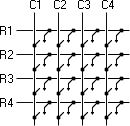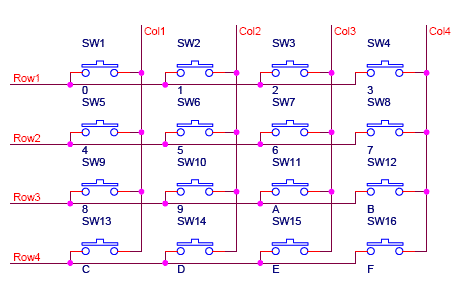►Programming 8051 Microcontroller
►8051 Assembly Program for 4x4 Keypad Matrix
►C Program for 4x4 Keypad Matrix
Example of how to use the above functions is given here.
►8051 Assembly Program for 4x4 Keypad Matrix
CODE:
keyport equ P2 ;Keypad port connected here
col1 equ P2.0 ;Column 1
col2 equ P2.1 ;Column 2
col3 equ P2.2 ;Column 3
col4 equ P2.3 ;Column 4
keyval equ 30H ;To store key number
pressed bit 0H ;Flag
key_init:
mov keyport,#0FH ;Make rows as o/p and col as i/p
ret
get_key:
mov keyval,#0 ;reset the number
mov keyport,#7FH ;make Row1 low
acall read_col ;read columns
jb pressed, done ;check if flag is set
mov keyval,#4 ;if not then read next row
mov keyport,#0BFH ;make Row2 low
acall read_col ;read columns
jb pressed, done ;check if flag is set
mov keyval,#8 ;if not then read next row
mov keyport,#0DFH ;make row3 low
acall read_col ;read columns
jb pressed, done ;check if flag is set
mov keyval,#12 ;if not read row4
mov keyport,#0EFH ;make row4 low
acall read_col ;read columns
done:
ret
read_col: ;read columns routine
clr pressed ;reset the flag
jb col1, nextcol ;check if first key is pressed
jnb col1,$ ;if yes then wait for key release
setb pressed ;set the flag
ret
nextcol: ;read col2
jb col2, nextcol1 ;check if second key is pressed
jnb col2,$ ;if yes then wait for key release
inc keyval ;its key number 2
setb pressed ;set the flag
ret
nextcol1: ;read col3
jb col3, nextcol2 ;check if third key is pressed
jnb col3,$ ;if yes then wait for key release
inc keyval ;its key 3
inc keyval
setb pressed ;set the flag
ret
nextcol2: ;read column 4
jb col4, exit ;check if fourth key pressed
jnb col4,$ ;if yes then wait for key release
inc keyval ;its key 4
inc keyval
inc keyval
setb pressed ;set the flag
ret
exit: ;if no key is pressed
clr pressed ;clr the flag
clr keyval ;reset the number
ret
end
col1 equ P2.0 ;Column 1
col2 equ P2.1 ;Column 2
col3 equ P2.2 ;Column 3
col4 equ P2.3 ;Column 4
keyval equ 30H ;To store key number
pressed bit 0H ;Flag
key_init:
mov keyport,#0FH ;Make rows as o/p and col as i/p
ret
get_key:
mov keyval,#0 ;reset the number
mov keyport,#7FH ;make Row1 low
acall read_col ;read columns
jb pressed, done ;check if flag is set
mov keyval,#4 ;if not then read next row
mov keyport,#0BFH ;make Row2 low
acall read_col ;read columns
jb pressed, done ;check if flag is set
mov keyval,#8 ;if not then read next row
mov keyport,#0DFH ;make row3 low
acall read_col ;read columns
jb pressed, done ;check if flag is set
mov keyval,#12 ;if not read row4
mov keyport,#0EFH ;make row4 low
acall read_col ;read columns
done:
ret
read_col: ;read columns routine
clr pressed ;reset the flag
jb col1, nextcol ;check if first key is pressed
jnb col1,$ ;if yes then wait for key release
setb pressed ;set the flag
ret
nextcol: ;read col2
jb col2, nextcol1 ;check if second key is pressed
jnb col2,$ ;if yes then wait for key release
inc keyval ;its key number 2
setb pressed ;set the flag
ret
nextcol1: ;read col3
jb col3, nextcol2 ;check if third key is pressed
jnb col3,$ ;if yes then wait for key release
inc keyval ;its key 3
inc keyval
setb pressed ;set the flag
ret
nextcol2: ;read column 4
jb col4, exit ;check if fourth key pressed
jnb col4,$ ;if yes then wait for key release
inc keyval ;its key 4
inc keyval
inc keyval
setb pressed ;set the flag
ret
exit: ;if no key is pressed
clr pressed ;clr the flag
clr keyval ;reset the number
ret
end
►C Program for 4x4 Keypad Matrix
CODE:
#include <AT89X51.H> //Include file for 8051
#define keyport P2 //keypad connected to P2
#define col1 P2_0 //column 1
#define col2 P2_1 //column 2
#define col3 P2_2 //column 3
#define col4 P2_3 //column 4
#define TRUE 1 //some defines
#define FALSE 0
/*
+---------------------------------------+
| Prototype: void key_init(void); |
| Return Type: void |
| Arguments: None |
| Description: Initialize ports and |
| Keypad. |
+---------------------------------------+
*/
void key_init(){
keyport &=0x0F; //make Rows as o/p and cols are i/p
}
/*
+-----------------------------------------------+
| Prototype: unsigned char get_key(void); |
| Return Type: unsigned char |
| Arguments: None |
| Description: To read key from the keypad |
+-----------------------------------------------+
*/
unsigned char get_key(){
unsigned char i,k,key=0;
k=1;
for(i=0;i<4;i++){ //loop for 4 rows
keyport &=~(0x80>>i); //to make rows low 1 by 1
if(!col1){ //check if key1 is pressed
key = k+0; //set key number
while(!col1); //wait for release
return key; //return key number
}
if(!col2){ //check if key2 is pressed
key = k+1; //set key number
while(!col2); //wait for release
return key; //return key number
}
if(!col3){ //check if key3 is pressed
key = k+2; //set key number
while(!col3); //wait for release
return key; //return key number
}
if(!col4){ //check if key4 is pressed
key = k+3; //set key number
while(!col4); //wait for release
return key; //return key number
}
k+=4; //next row key number
keyport |= 0x80>>i; //make the row high again
}
return FALSE; //return false if no key pressed
}
#define keyport P2 //keypad connected to P2
#define col1 P2_0 //column 1
#define col2 P2_1 //column 2
#define col3 P2_2 //column 3
#define col4 P2_3 //column 4
#define TRUE 1 //some defines
#define FALSE 0
/*
+---------------------------------------+
| Prototype: void key_init(void); |
| Return Type: void |
| Arguments: None |
| Description: Initialize ports and |
| Keypad. |
+---------------------------------------+
*/
void key_init(){
keyport &=0x0F; //make Rows as o/p and cols are i/p
}
/*
+-----------------------------------------------+
| Prototype: unsigned char get_key(void); |
| Return Type: unsigned char |
| Arguments: None |
| Description: To read key from the keypad |
+-----------------------------------------------+
*/
unsigned char get_key(){
unsigned char i,k,key=0;
k=1;
for(i=0;i<4;i++){ //loop for 4 rows
keyport &=~(0x80>>i); //to make rows low 1 by 1
if(!col1){ //check if key1 is pressed
key = k+0; //set key number
while(!col1); //wait for release
return key; //return key number
}
if(!col2){ //check if key2 is pressed
key = k+1; //set key number
while(!col2); //wait for release
return key; //return key number
}
if(!col3){ //check if key3 is pressed
key = k+2; //set key number
while(!col3); //wait for release
return key; //return key number
}
if(!col4){ //check if key4 is pressed
key = k+3; //set key number
while(!col4); //wait for release
return key; //return key number
}
k+=4; //next row key number
keyport |= 0x80>>i; //make the row high again
}
return FALSE; //return false if no key pressed
}
Example of how to use the above functions is given here.
 [/lightbox]
[/lightbox] [/lightbox]
[/lightbox]
